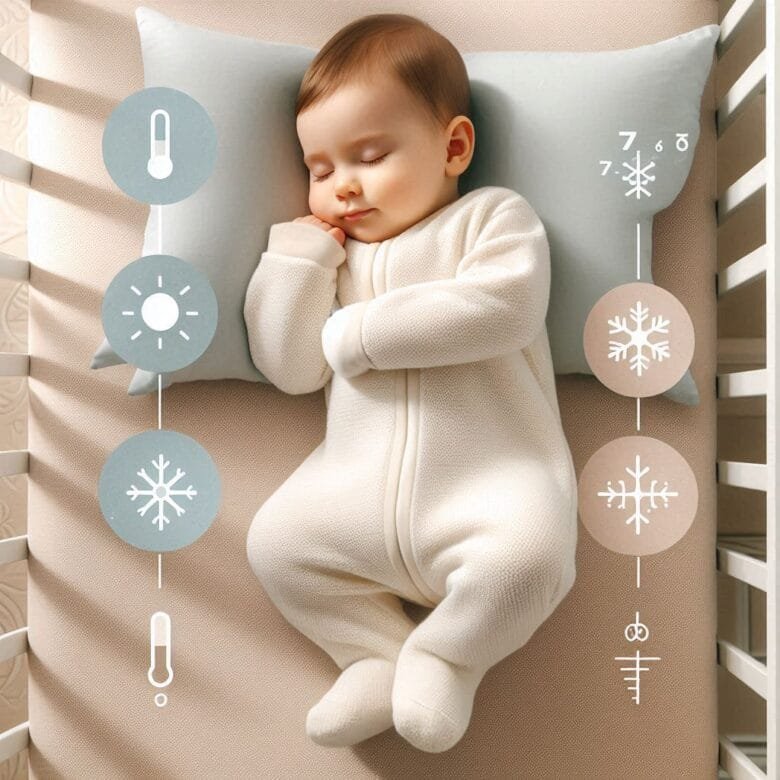Best Sleeping Temperature for Newborns
Creating the ideal sleeping environment for your newborn is crucial for their comfort and safety. The recommended room temperature for infants typically falls within the range of 68°F to 72°F (20°C to 22°C). Maintaining this temperature is essential because both overheating and excessive chill can disrupt a baby’s sleep and potentially pose health risks.
Regulating the temperature and understanding how to dress your baby for sleep is vital in achieving a comfortable sleeping environment. When determining how to dress baby for sleep, consider the room temperature alongside factors such as the type of sleepwear, bedding materials, and the baby’s own warmth. Lightweight sleep sacks or wearable blankets can help keep babies snug without the risk of overheating.
Monitoring your baby’s temperature effectively is important. You can observe physical signs such as sweating, flushed cheeks, or cool extremities to gauge their comfort level. For an accurate assessment, parents can utilize thermometers designed for infants to check if the room remains within the optimal sleeping temperature range. Additionally, parents should be ready to adjust their baby’s attire according to seasonal variations. For instance, in summer, lightweight clothing is advised, while winter may require warmer fabrics.
Furthermore, utilizing fans or heaters can assist in maintaining a stable room temperature, especially in climates that experience rapid temperature fluctuations. However, ensure that these are used judiciously, as direct drafts can lead to discomfort. When you are aware of how to dress baby for sleep in various conditions and monitor their comfort, you set the stage for restful nights and a more settled baby.
What Should My Baby Wear to Sleep?
Choosing the appropriate sleepwear for your baby is crucial for ensuring a comfortable and safe sleeping environment. When considering how to dress a baby for sleep, various clothing options are available, including sleep sacks, onesies, and pajamas. Each type brings specific benefits and considerations that must be taken into account, particularly in relation to seasonal changes.
One of the most popular choices is a sleep sack, which provides warmth without the need for loose blankets that could pose a suffocation hazard. When dressing your baby for sleep in summer, opt for lightweight, breathable fabrics, such as cotton, to prevent overheating. Sleep sacks or short-sleeved onesies can be excellent choices during warmer months. Conversely, when winter approaches, you may want to dress your baby for sleep in warmer options, like thicker sleep sacks or long-sleeved pajamas made from cozy materials to retain heat.
The fit of the sleepwear is another critical factor. Avoid any loose or bulky items; they can restrict your baby’s movements and may lead to safety concerns. Clothing should fit snugly without being too tight, allowing freedom of movement while still providing a secure feeling. It is advisable to select sizes that accommodate growth spurts, as babies can quickly outgrow their clothing. Make sure to check the manufacturer’s guidelines for the correct sizing and layer appropriately based on the room temperature.
While experimenting with layering during different seasons, always prioritize your baby’s comfort. For example, if the room is a bit chilly, dressing your baby in a light onesie under a sleep sack can work well. Refrain from overdressing, as overheating can be dangerous. By keeping these considerations in mind, parents can ensure their babies are dressed appropriately for restful sleep.
How to Dress Baby for Sleep in Summer
During the warmer summer months, it is essential to consider how to dress your baby for sleep to ensure they remain comfortable and cool throughout the night. The key is to choose lightweight, breathable fabrics that promote air circulation and reduce the possibility of overheating. Cotton and muslin are ideal choices, as they are soft against your baby’s skin and enable moisture-wicking, allowing sweat to evaporate easily.
To prevent your baby from getting too warm, maintaining a comfortable room temperature is crucial. A room temperature between 68°F to 72°F (20°C to 22°C) is generally recommended for infants. You may also find it beneficial to utilize fans or air conditioning to promote proper airflow without using excessive bedding. Additionally, employing a sleep sack or light swaddle makes it easier to regulate your baby’s temperature while providing the security of a cozy embrace.
Creating a conducive sleeping environment is equally important. Utilizing blackout curtains can help to minimize light disturbances, promoting better sleep. Proper airflow, especially in a warm climate, is vital. Opening a window or using a fan can enhance ventilation but ensure that no direct drafts hit the baby. Furthermore, during daytime hours, it is important to expose your baby to sunlight for short periods. This not only regulates their circadian rhythm but also aids in healthy sleep patterns at night. However, always keep in mind the importance of sun protection. Ensure that your baby is adequately covered and protected with sun-safe clothing or blankets when outdoors.
Understanding how to dress your baby for sleep in summer not only guarantees comfort but significantly contributes to their overall well-being during the warmest nights.
How to Dress Baby for Sleep in Winter
As temperatures drop during the winter months, it becomes essential for parents to know how to dress their baby for sleep properly. The primary goal is to keep your baby snug and warm without causing overheating, which can pose serious risks. Selecting the right fabrics is crucial when dressing your baby for sleep. Opt for sleepwear made from warmer materials such as fleece or thermal fabrics. These materials provide excellent insulation while remaining breathable, ensuring your baby stays comfortable throughout the night.
Layering is another effective technique for maintaining warmth. Consider starting with a long-sleeve bodysuit as a base layer. Over this, you can add a sleep sack or wearable blanket that is specifically designed for colder weather. Sleep sacks come in various weights, so choose one that is appropriate for the current temperature of your home. This allows you to adjust your baby’s attire according to the environment, ensuring they are neither too cold nor too hot.
In addition to appropriate clothing, it is advisable to pre-warm the crib or sleep area. This can be done by placing a warm water bottle in the crib for a few minutes before laying your baby down. Just remember to remove it before putting your baby to sleep to avoid any risks. Keeping a healthy humidity level in the bedroom is also important during winter, as dry air can lead to discomfort for your little one. Use a humidifier if necessary to maintain a comfortable sleeping atmosphere.
Lastly, while it may be tempting to use heavy blankets for added warmth, it is crucial to prioritize safety. Instead of traditional blankets, consider using swaddles or sleep sacks that are designed to reduce suffocation risks. By taking the time to ensure your baby is dressed appropriately for sleeping in winter, you can help create a safe and cozy sleep environment.

